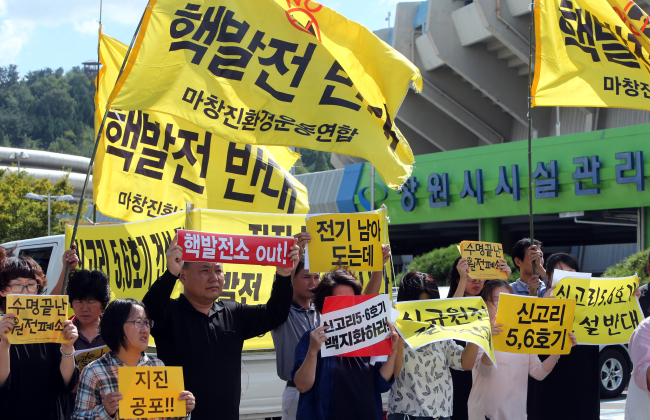A magnitude 4.5 earthquake struck near the historic city of Gyeongju in the nation’s southeastern region Monday night, a week after two strong earthquakes jolted the same city.
The Korea Meteorological Administration said that the quake hit a depth of 14 kilometers at 8:33 p.m., with the epicenter located some 11 kilometers south of Gyeongju in what is believed to be the biggest aftershock.
Seismic monitors recorded more than 400 aftershocks as of Tuesday morning since the quake -- the largest ever recorded by the KMA in the Korean Peninsula -- rattled the country on Sept. 12. Most of the earlier aftershocks were assessed to be weaker than magnitude 3.0 quakes. Only two aftershocks were in the range of magnitude between 4.0 and 5.0.
Local experts mostly suggested that the latest quake is an aftershock, with many of them expecting to see more aftershocks in the weeks to come.
Sohn Moon, a geology professor from Busan National University, told a local media outlet that an earthquake even stronger than 6.0 magnitude is possible due to fault lines affected by a series of tremors.
“Aftershocks sometimes last for more than a year. The worst quake that took place in Gyeongju shook fault lines and we don’t know how surrounding fault lines will move around,” he was quoted as saying.
“We don’t know whether the latest quake was an aftershock or a precursor to bigger quakes in the years to come. We need to find ways to minimize damage.”
 |
Civic group members hold a rally in Changwon, South Gyeongsang Province, demanding the halt in operations of nuclear power plants following the record-breaking earthquake and aftershocks that rattled the southern region of the peninsula in the past week. (Yonhap) |
Fire stations received a total of 14,530 emergency calls from residents who felt tremors nationwide, authorities said. Daegu, Uslan and North Gyeongsang Province near the quake-hit city had more than 4,000 reports, mostly about buildings shaken by the quake.
While there were no reports of serious damage or fatalities, there were a total of 12 damage reports including cracks in houses and collapses of walls, according to the Ministry of Public Safety and Security.
It was reported that students who went on a school trip to Gyeongju returned home and several schools across the country cancelled trips to the city out of safety reasons in the face of the earthquake.
Some 30 schools in Gyeonggi Province had planned trips to the city in the coming weeks, but the Gyeonggi Provincial Education Office ordered schools to refrain from visiting the area, the education office said.
Gyeongju, the old capital of the Silla Kingdom (57 B.C.-935 A.D.) located some 370 kilometers southeast of Seoul, is a popular destination for Korean students due to its vast cultural heritage and historic sites.
The Busan and Daegu regional education offices said they ordered students to evacuate playgrounds outside schools and sent them home as soon as the quake rocked the country.
South Korea has been considered relatively safe from earthquakes, but a string of seismic activity has triggered public concerns over what they see as the government’s inability to cope with them.
On Monday night, warning messages were sent to the public in quake-hit areas only 12 minutes after the quake jolted the country. The website of the Public Safety Ministry as well as the weather agency, which provide information on how to evacuate in cases of quakes, also crashed due to heavy traffic.
“I felt the tremors while studying at a library and people started to rush out of the building. Library staff members evacuated students and temporarily shut down the building,” said Kim Gyeong-deok, a 26-year-old university student living in Daegu.
Television footage showed residents fleeing onto the streets as the tremor struck the country which has experienced little seismic activity unlike neighboring Japan.
Kim said that he had received a warning text message from the Public Safety Ministry much earlier than he did on Sept. 12 when the record-breaking quake shook the nation.
“For me, I have no idea about what to do when the quake strikes. The government should prepare measures to promptly inform the public of how to respond in emergency cases,” he said.
Nuclear plants were not damaged by the quake and are operating as normal, the Korea Hydro & Nuclear Power said. Four reactors remain closed following the 5.8 magnitude quake for routine inspection, it added.
The country’s nuclear reactors are designed to withstand magnitude 6.5 to 7.0 earthquakes. The KHNP plans to improve 24 nuclear reactors to make them able to withstand up to 7.0 magnitude earthquakes by April 2018, it said.
The Ministry of Land, Infrastructure and Transport said that it would revise a relevant act to require all new buildings in the country that are higher than one story and bigger than 500 square meters in area to be resistant to earthquakes from next year.
Currently, only buildings that are three stories or higher and that are bigger than 500 square meters are required to be earthquake-resistant.
It also said that those with 16 stories or more must have their earthquake-proof designs verified and show how strong a quake they can withstand.
By Ock Hyun-ju (
laeticia.ock@heraldcorp.com)








